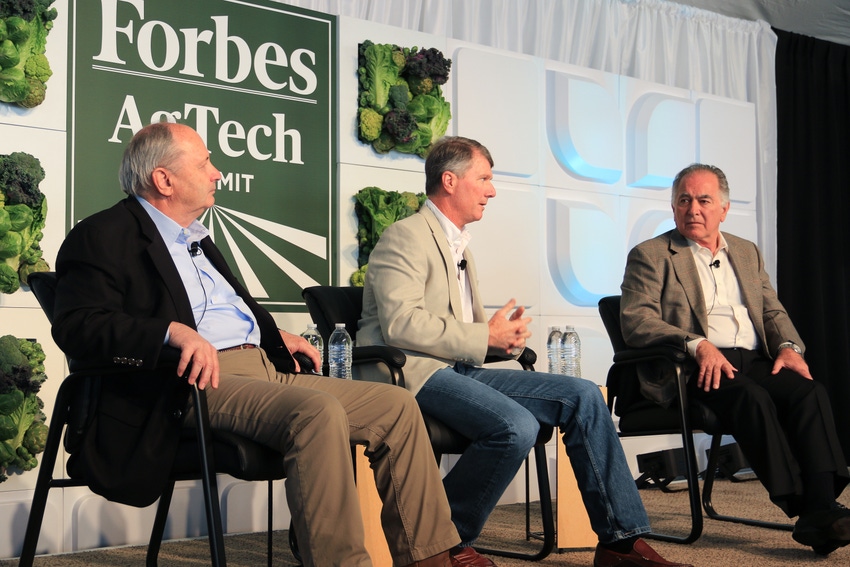
Salinas, Calif. has long been recognized as America’s salad bowl because of its vegetable production, but it’s the region’s neighbor to the north that is helping refocus the spotlight on more than its agricultural prowess.
About 75 miles north of the Salinas Valley is another more famous valley venue, long dubbed the “Silicon Valley” for its creation of computer technology.
There’s a move afoot to connect the two regions in a way that benefits agriculture while feeding venture capitalists with a new source of income.
The second Forbes AgTech Summit recently drew more than 600 people from agriculture and technology circles to downtown Salinas. The event sought to gather agricultural and high-tech leaders to ultimately connect farmers around the globe with the technology needed to improve efficiencies and reduce production costs.
Salinas Mayor Joe Gunter says his city is well-positioned to bring farmers and high-tech entrepreneurs together because of its proximity to technology firms of the Silicon Valley. Like this valley, there is value in the rich, dark soils of the Salinas Valley.
Last year Monterey County – home to the Salinas Valley – grossed more than $4.8 billion in direct agricultural sales, according to the county agricultural department.
Topics of discussion
Labor issues remain a key concern for growers and food processors, according to Tom Nassif, president and chief executive officer for Western Growers Association (WGA), an agricultural trade association that represents about half of the nation’s fruit, vegetable and tree nut production in Arizona, California, and Colorado.
“Our labor supply is at a critical stage right now, as is our water supply,” Nassif said.
Addressing labor and on-farm efficiencies were largely what encouraged WGA leadership to develop the Western Growers Association Center for Innovation and Technology, a high-tech incubator that mentors start-up companies. It provides the necessary introductions into the agricultural sector that could ultimately help growers address ongoing challenges.
The center opened in the last year in downtown Salinas and is currently home to over 20 start-up companies.
Nassif moderated a discussion at the Forbes AgTech Summit that included Samuel Duda and Harold McClarty. Duda is vice president of western vegetable operations with Duda Farms, a U.S.-based company with agricultural operations in seven states, including California and Arizona.
McClarty is owner and co-founder of HMC Farms in Kingsburg, Calif., a grower and processor of stone fruit and table grapes.
The trio shared how the lack of labor is affecting growing and packing operations that rely on people to hand pick fresh fruits and vegetables.
No congressional support
According to Nassif, a group of U.S. agricultural representatives met with a bipartisan group of U.S. senators several years ago to work on an immigration reform bill with the goal of addressing labor shortages. The bill went nowhere because it couldn’t pass the U.S. House of Representatives.
Now, Nassif says agricultural leaders are working with the governors of states affected by immigration issues to pressure Congress to address immigration reform and agriculture’s labor shortages.
For McClarty, labor is the deciding factor in his business’ ability to expand.
“We believe that more than water or anything else, labor has that large an effect on whether we will be able to continue to produce and be competitive,” McClarty said.
“We are probably at half the volume of stone fruit that we were perhaps 10 years ago,” McClarty continued. “We have lost blocks (of fruit) this year simply because we couldn’t get the labor we needed. It’s not going to get any better. We’re at a tipping point where we need a combination of technology and labor to help us stay competitive. I can’t keep raising my prices; it won’t work in the marketplace."
“The labor supply is not going up, no matter what anybody says,” McClarty continued.
According to Duda, circumstances are much the same for Duda Farms.
“We’re having some of the same issues Harold is having,” Duda told the audience. “We don’t know if we’ll have the labor or how we’re going to pay for it, which has created doubt about the future.”
The challenges of automating current labor practices won’t be easy, Duda said.
“The dexterity of picking food and the ability of the eye to distinguish quality is our biggest challenge,” he said.
Duda also referenced the ever increasing cost of labor compared to the relative stability that mechanization would add to the process.
“If you look just at the California minimum wage increase. For every dollar an hour it goes up is another $1 million in wages we have to pay over the course of a year, and that doesn’t include the benefits package,” Duda said.
It’s not just the hard costs of labor that concern growers including Duda and McClarty, but the competition it creates from overseas markets.
Foreign competition does not simply mean cheaper fruit competing with growing costs of domestic production, McClarty argued. Domestic fruit will simply become unavailable because of the inability to find labor. As this happens, McClarty sees opportunity closing to U.S. farmers and opening to foreign imports of fruits and vegetables.
Nassif said the overall balance of trade for produce is negative in the United States, meaning more produce is coming in from other countries than the amount produced domestically.
“How do you compete with that when you have more regulations and less labor?” Nassif asked.
While Nassif is optimistic about new technology, “practically new technologies are still running behind agriculture’s needs,” Nasif said. "We have terrible labor shortages and we’re not able to make up for that through robotics or mechanization just yet.”
About the Author(s)
You May Also Like






